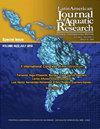智利南部两条重要的休闲渔业河流中奇努克鲑鱼(Oncorhynchus tshawytscha)与鳟鱼种群的同居
IF 0.8
4区 农林科学
Q3 FISHERIES
Latin American Journal of Aquatic Research
Pub Date : 2022-11-01
DOI:10.3856/vol50-issue5-fulltext-2906
引用次数: 1
摘要
对智利南部两条重要的休闲捕鱼河流Petrohué河和Puelo河进行了一项研究,以评估居住在这两条河流中的鲑鱼物种的种群结构。在2016年4月至2017年2月的四个日期,对五个河段进行了调查。在Petrohué河,对2400条鱼进行了采样(42.9%的虹鳟Oncorhynchus mykiss;23.8%的褐鳟Salmo trutta和33.3%的Chinook三文鱼Oncorhytchus tshawytscha),而在Puelo河,对1972条鱼进行了检查(51.6%的虹鳟鱼;30.4%的褐鳟鱼和18%的Chinok三文鱼)。在通过电捕鱼收集的鱼类中,鱼苗和鱼种阶段所占比例最高。在Petrohué河和Puelo河,虹鳟鱼苗和鱼种分别占采样鱼类的96.3%和99.2%;褐鳟鱼的比例分别为96.8%和97.1%,而奇努克鲑鱼、鹦鹉鱼和预混鱼分别占Petrohué河和Puelo河检查鱼类的97%和98.3%。虹鳟和褐鳟在这两条河流中有着相同的栖息地和食物,这两条最古老的鳟鱼记录了5年多和6年多的历史。Parr和Presmolt Chinook三文鱼主要出现在冬季和春季,年龄分别为1+和2+。在两条河流中取样的幼鱼记录的食物项目没有差异。年龄在1.5岁以上至1.6岁以上的成熟、回归的成年奇努克鲑鱼没有食物,在秋季的记录中,Petrohué河的数量最高。该研究没有发现共享同一栖息地的三种主要鲑属物种之间存在任何不利竞争或负面相互作用。本文章由计算机程序翻译,如有差异,请以英文原文为准。
The cohabitation of Chinook salmon (Oncorhynchus tshawytscha) with trout populations in two important recreational fishing rivers in southern Chile
A study was carried out on two important recreational fishing rivers in southern Chile, the Petrohué and the Puelo, to assess the population structure of the salmonid species inhabiting both rivers. Five river sectors were surveyed on four dates between April 2016 and February 2017. In the Petrohué River, 2400 fish were sampled (42.9% rainbow trout Oncorhynchus mykiss; 23.8% brown trout Salmo trutta, and 33.3% Chinook salmon Oncorhynchus tshawytscha), while in the Puelo River, 1972 fish were examined (51.6% rainbow trout; 30.4% brown trout and 18% Chinook salmon). Fry and fingerling stages accounted for the highest proportion of fish collected by electrofishing. In the Petrohué and Puelo rivers, rainbow trout fry and fingerlings represented 96.3 and 99.2% of the fish sampled, respectively; 96.8 and 97.1% in the case of brown trout, while for Chinook salmon, parr and pre-smolts represented 97% of the fish examined in the Petrohué River and 98.3% in the Puelo River. Rainbow and brown trout shared the same habitats and food items in both rivers, and the two oldest trout recorded 5+ and 6+years. Parr and pre-smolt Chinook salmon were present mainly in the winter and spring seasons and were aged 1+ and 2+, respectively. There were no differences in the food items recorded from the juvenile fish sampled in both rivers. The mature, returning adult Chinook salmon aged between 1.5+ and 1.6+ years were devoid of food and were recorded over the autumn season with the highest abundance in the Petrohué River. The study did not identify any adverse competition or negative interactions among the three main salmonid species sharing the same habitat.
求助全文
通过发布文献求助,成功后即可免费获取论文全文。
去求助
来源期刊

Latin American Journal of Aquatic Research
FISHERIES-MARINE & FRESHWATER BIOLOGY
CiteScore
1.70
自引率
10.00%
发文量
44
审稿时长
4-8 weeks
期刊介绍:
Latin American Journal of Aquatic Research- LAJAR is the continuation of the journal Investigaciones Marinas (1970-2007) and is published since 2008 by the Escuela de Ciencias del Mar, Facultad de Ciencias del Mar y Geografía of the Pontificia Universidad Católica de Valparaíso. LAJAR is an “Open Access” journal that publishes in English language, original research articles, reviews and short communications on aquatic science, which contain the results of research conducted in aquaculture or in oceanic and coastal marine waters of Latin America.
The following topics are considered: Physical Oceanography, Chemical Oceanography, Marine Biogeochemistry, Marine Pollution and Toxicology, Marine Geology and Geophysics, Biological Oceanography, Fisheries and Aquaculture.
 求助内容:
求助内容: 应助结果提醒方式:
应助结果提醒方式:


